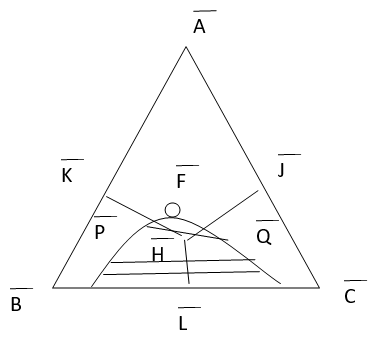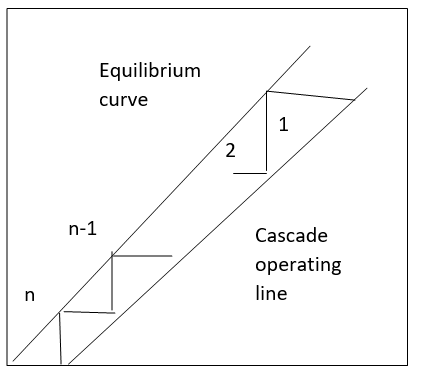This set of Bioseparation Processes Multiple Choice Questions & Answers (MCQs) focuses on “Theory of Extraction”.
1. What is the significance of the given figure?

a) Ternary phase diagram for partially miscible solvent system
b) Phase diagram
c) Triangular diagram
d) Solvent system
View Answer
Explanation: The diagram shows different components in an extraction process which explains the ternary phase diagram for partially miscible solvent system. The feed consists of the solute to be extracted in the fermentation media and the extracting solvent is the phase to which the solute is transferred.
2. Which of the following is correct way of expressing the principle of solvent extraction?
a)

b)

c)

d)

View Answer
Explanation: The different components involved in an extraction processes are feed, extracting solvent, extract and raffinate. The feed consists of the solute to be extracted in the original solvent. The extracting solvent is the phase to which the solute is to be transferred and device within which this transfer of solute takes place is called an extractor. The raffinate is the spent feed while the extract is the enriched extracting solvent.
3. What is the significance of the given diagram?

a) Principle of extraction
b) Extraction process
c) Feed diagram
d) Concurrent extraction cascade
View Answer
Explanation: In order to achieve high product recovery in the process of extraction, the use of frequent more than one stage extraction is necessary. The process of extraction is usually set up where the extraction solvent and the feed run countercurrent to each other.
4. What is the need of counter current flow?
a) Feed flow
b) Cocurrent flow
c) Raffinate flow
d) Extract flow
View Answer
Explanation: The counter current flow is used for concurrent flow because the solute concentration difference between the raffinate and extraction phases, the driving force for the process, is greater in the countercurrent flow.
5. Concurrent extraction is analysed both graphically and analytically for equilibrium in each stage of contacting.
a) True
b) False
View Answer
Explanation: The analysis helps in determination of the balance between the number of stages and the ration of the extraction flow rate to the flow rate of feed. Therefore, it the counter current extraction is analysed both graphically and analytically for equilibrium in each stage of contacting.
6. What are the assumptions for the calculation of extraction efficiency?
a) Immiscible solvents, low solute concentration, constant flow rate
b) Constant flow rate, equilibrium at each stage
c) Immiscible solvents, low solute concentration, equilibrium at each stage
d) equilibrium at each stage, Immiscible solvents
View Answer
Explanation: The three key assumptions are: the two solvents are immiscible or are already in phase equilibrium, the solute concentrations are sufficiently low that the flow rates of the raffinate and extract are constant, equilibrium is achieved in each stage. The first assumption depends on the solvents that are chosen. The second assumption typically holds for the extraction of bioproducts.
7. What is the material balance for the solute around the feed end of the cascade?
a) xf F + ynS = xn-1F + y1S
b) xf F – ynS = xn-1F + y1S
c) xf F + ynS = xn-1F – y1S
d) xf F + ynS ≠ xn-1F + y1S
View Answer
Explanation: The material balance for the solute around the feed end of the cascade is expressed by xfF + ynS = xn-1F + y1S where, F is the rate of feed or raffinate phase, S is the flow rate od extract phase and the concentrations are defined by the constants used and the equation can be rearranged as: yn = \(\frac{F}{S}\)xn-1 = \(\frac{y_1 S – x_f F}{S}\).
8. What is operating line in the equation yn = \(\frac{F}{S}\)xn-1 = \(\frac{y_1 S – x_f F}{S}\)?
a) y1S – xfF
b) \(\frac{F}{S}\)
c) \(\frac{F}{S}\)xn-1
d) \(\frac{y_1 S – x_f F}{S}\)
View Answer
Explanation: yn and xn-1 are concentrations of passing streams on a line of slope \(\frac{F}{S}\) is called operating line. The calculation of the number of stages required to reduce the concentration of solute in the feed stream to xn.
9. What can be interpreted from the given diagram?

a) Calculation of extraction
b) Calculation of extraction factor
c) Calculation of number of stages
d) Calculation of concentration
View Answer
Explanation: The given diagram is McCabe-Thiele type diagram which is used for the calculation of number of stages required to reduce the concentration of solute in the feed stream to xn can be carried out graphically.
10. Calculate the extraction factor for the 2.5 partition coefficient and 1.5 cascades operating line of an extraction process for isothermal, dilute solutions.
a) 1.36
b) 1.46
c) 1.56
d) 1.66
View Answer
Explanation: The extraction factor E = \(\frac{K}{\frac{F}{S}}\) ∴ E = \(\frac{2.5}{1.5}\) = 1.66. So, the extraction factor for the operating line of an extraction process for isothermal, dilute solutions is 1.66.
Sanfoundry Global Education & Learning Series – Bioseparation Processes.
To practice all areas of Bioseparation Processes, here is complete set of 1000+ Multiple Choice Questions and Answers.
If you find a mistake in question / option / answer, kindly take a screenshot and email to [email protected]
